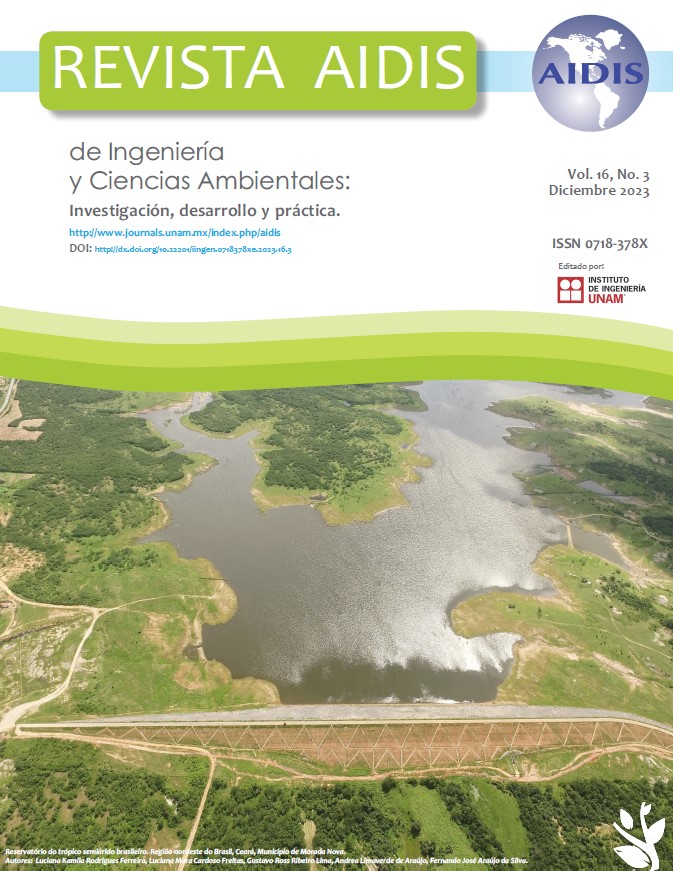ENVIRONMENTAL MONITORING OF URBAN STREAM IN THE MUNICIPALITY OF PALMAS – TO
Main Article Content
Abstract
In order to disseminate knowledge about the control of anthropic activities arising from the implementation of large urban centers, this research had the objective to analyze qualitative and quantitative parameters about the water bodies of the Palmas-TO city as a baseline to the actions of Ambiental monitoring in the urban watersheds of this region. The study area is compost for 8 water bodies inside the macrozone of the territorial ordering of the municipium with the streams: Cachimbo, Sussuapara, Brejo Comprido, Prata, Machado, Santa Barbara e Taquari. It was determined the parameters physico-chemistry and microbiology of the stream’s quality water. The evaluation of hydrological aspects was made by the flow measurements, using the equipment Flowtracker serial P5001 and Sontek riversurveyor M9. The water quality results were evaluated according to CONAMA Resolution 357/05, for Class 2 water bodies. The results provides evidences that the degradation of the water’s quality in the urban streams is a result of the urban expansion, that requires control actions and land use planning in order to minimize the environmental impacts and enabling to follow the the water quality standards pre-established by the Brazilian legislation.
Article Details
Citas en Dimensions Service
References
Amaral, C.L.C., Saron, A. (2017). Aprendizagem de índice de qualidade da água a partir da aplicação de uma unidade de ensino potencialmente significativa. EOL 87–101. Acesso em 16 de agosto de 2020, disponível em: https://doi.org/10.36556/eol.vi25.278
Bollmann, H.A., Marques, D.M.L. da M. (2006). Influência da densidade populacional nas relações entre matéria orgânica carbonácea, nitrogênio e fósforo em rios urbanos situados em áreas com baixa cobertura sanitária. Doutorado em Engenharia Ambiental (Imperial College). 11, 343–352. Acesso em 16 de agosto de 2020, disponível em: https://doi.org/10.1590/S1413-41522006000400007Wang, R., Kim, J., Li, M. (2021). Predicting stream water quality under different urban development pattern scenarios with an interpretable machine learning approach, Science of the Total Environment, 761, 144057. Acesso em 20 de outubro de 2021, disponível em: https://doi.org/10.1016/j.scitotenv.2020.144057
Brasil (1997) Lei nº 9.433, de 8 de janeiro de 1997 Institui a Política Nacional de Recursos Hídricos, cria o Sistema Nacional de Gerenciamento de Recursos Hídricos, regulamenta o inciso XIX do art. 21 da Constituição Federal, e altera o art. 1º da Lei nº 8.001, de 13 de março de 1990, que modificou a Lei nº 7.990, de 28 de dezembro de 1989. Brasília, Brasil, D.O.U de 09/01/1997, 470 pp. Acesso em: 05 de junho de 2020. Disponível em: http://www.planalto.gov.br/ccivil_03/leis/l9433.htm
CONAMA, Conselho Nacional do Meio Ambiente, Resolução n° 357 (2005) Dispõe sobre a classificação dos corpos de água e diretrizes ambientais para o seu enquadramento, bem como estabelece as condições e padrões de lançamento de efluentes, e dá outras providências. Publicação Diário Oficial da República Federativa do Brasil, Brasília - DF, 17 de março de 2005.. Acesso em 06 de outubro de 20, disponível em: http://www2.mma.gov.br/port/conama/legiabre.cfm?codlegi=459
Liquete, C., Maes, J., Notte, A.L., Bidoglio, G. (2011). Securing water as a resource for society: an ecosystem services perspective, Ecohydrology & Hydrobiology, 11(3-4), 247-259. Acesso em 15 de julho de 2020, disponível em: https://doi.org/10.2478/v10104-011-0044-1
Khan, I., Lei, H., Muhammad, I., Zhao, M. (2021). Do residential localities matter? Revisiting preference heterogeneity and ranking of ecological attributes of an inland river basin. Science of The Total Environment, 763, 142970. Acesso em 22 de janeiro de 2022, disponível em: https://doi.org/10.1016/j.scitotenv.2020.142970
MMA, Ministério do Meio Ambiente (2007) Biodiversidade do Cerrado e Pantanal: áreas e ações prioritárias para conservação. Acesso em 16 de ago. de 2020, disponível em: http://www.bibliotecaflorestal.ufv.br/handle/123456789/5127
Mandaric, L., Mor, J.-R., Sabater, S., Petrovic, M. (2018). Impact of urban chemical pollution on water quality in small, rural and effluent-dominated Mediterranean streams and rivers. Science of The Total Environment, 613–614, 763–772. Acesso em 16 de agosto de 2020, disponível em: https://doi.org/10.1016/j.scitotenv.2017.09.128
Pereda, O., Schiller, D.V., García-Baquero, G., Mor, J.R., Acuña, V., Sabater, S., Elosegi, A. (2021). Combined effects of urban pollution and hydrological stress on ecosystem functions of Mediterranean streams, Science of The Total Environment, 753, 141971. Acesso em 12 de fevereiro de 2022, disponível em: https://doi.org/10.1016/j.scitotenv.2020.141971
Peluso, J., Pérez Coll, C.S., Aronzon, C.M. (2021). In situ exposure of amphibian larvae (Rhinella fernandezae) to assess water quality by means of oxidative stress biomarkers in water bodies with different anthropic influences. Chemosphere, 271, 129598. Acesso em 12 de fevereiro de 2022, disponível em: https://doi.org/10.1016/j.chemosphere.2021.129598
Peluso, J., Pérez Coll, C.S., Cristos, D., Rojas, D.E., Aronzon, C.M. (2021). Comprehensive assessment of water quality through different approaches: Physicochemical and ecotoxicological parameters. Science of The Total Environment, 800, 149510. Acesso em 16 de janeiro de 2022, disponível em: https://doi.org/10.1016/j.scitotenv.2021.149510
Ranta, E., Vidal-Abarca, M.R., Calapez, A.R., Feio, M.J. (2021). Urban stream assessment system (UsAs): An integrative tool to assess biodiversity, ecosystem functions and services, Ecological Indicators, 121, 106980. Acesso em 12 de fevereiro de 2022, disponível em: https://doi.org/10.1016/j.ecolind.2020.106980
Risal, A., Parajuli, P.B., Dash, P., Ouyang, Y., Linhoss, A. (2020). Sensitivity of hydrology and water quality to variation in land use and land cover data, Agricultural Water Management, 241, 106366. Acesso em 10 de setembro de 2021, disponível em: https://doi.org/10.1016/j.agwat.2020.106366
Santos, E.H.M., Griebeler, N.P., Oliveira, L.F.C. (2010). Relação entre uso do solo e comportamento hidrológico na Bacia Hidrográfica do Ribeirão João Leite, Rev. bras. eng. agríc. Ambiente, 14, 826–834. Acesso em 23 de setembro de 2020, disponível em: https://doi.org/10.1590/S1415-43662010000800006
Uprety, M., Ochoa-Tocachi, B.F., Paul, J.D., Regmi, S., Buytaert, W. (2019). Improving water resources management using participatory monitoring in a remote mountainous region of Nepal, Journal of Hydrology: Regional Studies, 23, 100604. Acesso em 15 de julho de 2020, disponível em: https://doi.org/10.1016/j.ejrh.2019.100604
Wang, R., Kim, J., Li, M. (2021). Predicting stream water quality under different urban development pattern scenarios with an interpretable machine learning approach, Science of the Total Environment, 761, 144057. Acesso em 20 de outubro de 2021, disponível em: https://doi.org/10.1016/j.scitotenv.2020.144057

This work is licensed under a Creative Commons Attribution-NonCommercial-NoDerivatives 4.0 International License.
